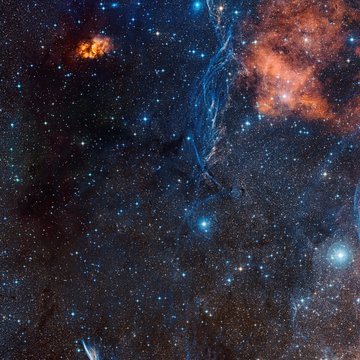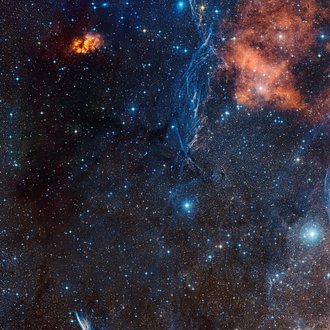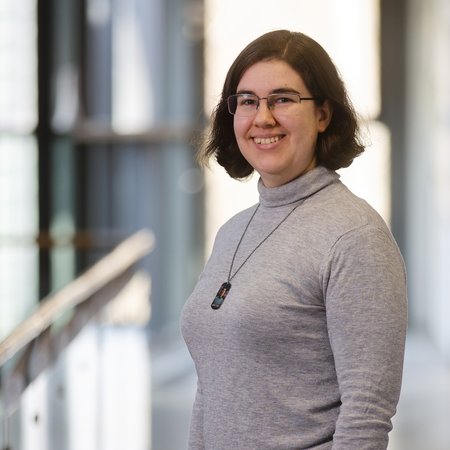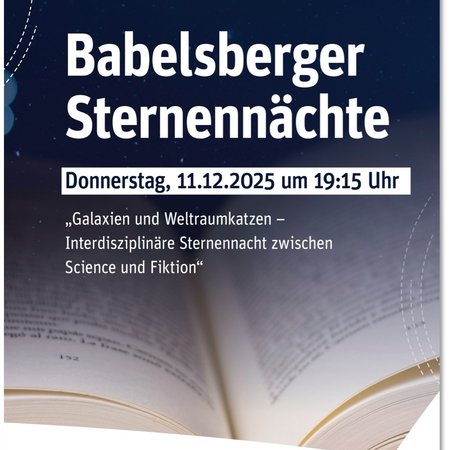Virtual lecture: Babelsberg Starry Night on 20 November 2025

Section of the sky with stars, clouds from star-forming regions and filament-like structures of a supernova remnant.
Credit: ESO/Digitized Sky Survey 2At the next virtual Babelsberg Starry Night of the Leibniz Institute for Astrophysics Potsdam (AIP), Dr Daniel Sablowski follows a photon, or particle of light, on its cosmic odyssey. The video will be broadcast on the YouTube channel ‘Urknall, Weltall und das Leben’ (Big Bang, Universe and Life) from 20 November 2025.
The next lecture in the virtual Babelsberg Starry Nights series will be online on Thursday at 8 p.m. Dr Daniel Sablowski is a research assistant in the Technical Section at AIP. In his lecture ‘The Odyssey of a Cosmic Photon’, he explains what can happen to the light on its journey from the vastness of space to observation with a telescope. Using spectrographs, researchers can break down the received light into its colour components and use such spectra to discover binary stars, the rotation of planets or even interstellar matter.
Usually on the 3rd Thursday of each month, starting at 8 p.m., the lectures of the Babelsberg Starry Nights become available at
https://www.aip.de/babelsberger-sternennaechte
and via the YouTube channels "Urknall, Weltall und das Leben" (Big Bang, Universe and Life) and "videowissen" and can be viewed afterwards at any time.
Further information
Now online: https://youtu.be/3XoJKsFM9XQ

Section of the sky with stars, clouds from star-forming regions and filament-like structures of a supernova remnant.
Credit: ESO/Digitized Sky Survey 2At the next virtual Babelsberg Starry Night of the Leibniz Institute for Astrophysics Potsdam (AIP), Dr Daniel Sablowski follows a photon, or particle of light, on its cosmic odyssey. The video will be broadcast on the YouTube channel ‘Urknall, Weltall und das Leben’ (Big Bang, Universe and Life) from 20 November 2025.
The next lecture in the virtual Babelsberg Starry Nights series will be online on Thursday at 8 p.m. Dr Daniel Sablowski is a research assistant in the Technical Section at AIP. In his lecture ‘The Odyssey of a Cosmic Photon’, he explains what can happen to the light on its journey from the vastness of space to observation with a telescope. Using spectrographs, researchers can break down the received light into its colour components and use such spectra to discover binary stars, the rotation of planets or even interstellar matter.
Usually on the 3rd Thursday of each month, starting at 8 p.m., the lectures of the Babelsberg Starry Nights become available at
https://www.aip.de/babelsberger-sternennaechte
and via the YouTube channels "Urknall, Weltall und das Leben" (Big Bang, Universe and Life) and "videowissen" and can be viewed afterwards at any time.
Further information
Now online: https://youtu.be/3XoJKsFM9XQ
Images
Section of the sky with stars, clouds from star-forming regions and filament-like structures of a supernova remnant.
Big screen size [1000 x 904, 330 KB]
Original size [4000 x 3619, 5.0 MB]



